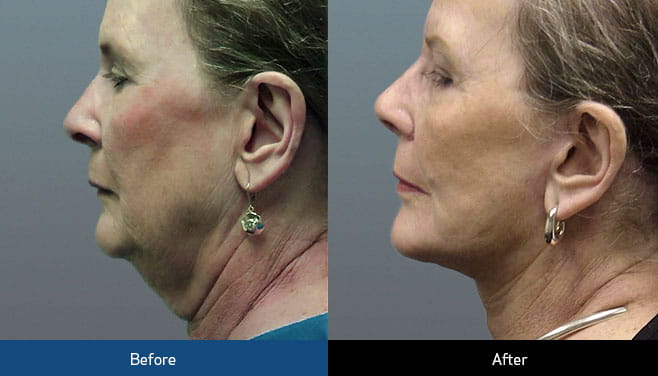FaceLift
Mild yet troublesome asymmetry is not infrequent after recovery from complete facial paralysis/ Bell's Palsy or following major reconstructive surgery. Refinement procedures such as the face lift (cervicofacial rhytidectomy) provide the opportunity to further enhance an individuals form and function.
Traditional facelift procedures have their greatest effect on improving irregularities in the neck, lower cheeks and jowls.

The procedures are usually performed bilaterally in an effort to maximize facial equilibrium and balance.
Click here to enlarge photo
Technique
The facelift procedure is usually approached through an incision that follows a series of natural creases around the ear and eventually hides in the hair of the scalp. A second incision may be made beneath the chin to remove fat and tighten loose muscles that form an unpleasant contour (turkey gobbler).
The skin and fat are partially elevated from the cheeks and neck allowing access to the more supportive layer of the face (SMAS). This dense layer of tissue is then relocated and tightened to help reduce the effects of Facial Paralysis/ Bells Palsy and aging. The skin is now re-draped and the excess removed. The incisions are closed over small drainage tubes with plastic surgery techniques.
Recovery
After undergoing a facelift procedure patients usually stay overnight in the hospital and are discharged the morning after surgery. During the period of observation frequent checks are performed to rule out the development of blood collections beneath the skin (hematoma) that might require a return to the operating room.
In an effort to prevent hematoma formation, patients are asked to avoid drugs with blood thinning effects such as aspirin, ibuprofen, clopidogrel (Plavix) and some herbal preparations for a period of several weeks before surgery. Other rare complications associated with face lift procedures include damage to the facial nerve, numbness of the ear lobes and skin necrosis.
Wound healing problems are more common with smokers and a heavy smoking history will often result in the performance of a more limited procedure. In general face lift procedures are well tolerated and have low complication rates. After undergoing this procedure a 4-6 week recovery will be needed to allow for resolution of bruising and swelling prior to attending a major social event.
real patient case studies
Learn how facial paralysis surgery and functional restoration can help you.
